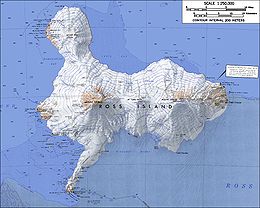Ross Island
This article may have too many red links. (November 2011) |
Ross Island is an island which was formed by four volcanoes in the Ross Sea, which can be found near the continent, Antarctica.
 Map of Ross Island | |
| Geography | |
|---|---|
| Location | Antarctica |
| Coordinates | 77°40′S 168°00′E / 77.667°S 168.000°E |
| Area | 2,460 km2 (950 sq mi) |
| Highest elevation | 3,794 m (12448 ft) |
| Highest point | Erebus |
| Administration | |
Antarctica | |
| Additional information | |
| Administered under the Antarctic Treaty System | |


Geography
changeBecause of the persistent presence of the ice sheet, the island is sometimes mistaken to be a part of Antarctica. Its area is 2,460 km² (950 sq mi); only a small portion of the island is free of ice and snow. The planet's southernmost active volcano, Erebus (3794 m), as well as the dormant volcano Terror (3230 m), are situated on the island. They were named by Ross after his ships HMS Erebus and HMS Terror. The third highest peak is Mount Bird, and on its slopes are Shell Glacier and Endeavour Piedmont Glacier. Abbott Peak stands between Mount Erebus and Mount Bird.
Despite its relatively small size, Ross Island is the world's 6th highest island.
Discovery
changeThe island was discovered by Sir James Clark Ross in 1841, and it was later named in his honour by Robert F. Scott.
Ross Island was the base for many of the early expeditions to Antarctica. It was and still is the southernmost island reachable by sea. Huts built by Scott's and Shackleton's expeditions are still located on the island, preserved as historical sites.
Today Ross Island is home to New Zealand's Scott Base, and the largest Antarctic settlement, the U.S. Antarctic Program's McMurdo Station. Greenpeace established World Park Base on the island and it ran for five years, from 1987 to 1992.
Claims
changeRoss Island lies within the boundaries of Ross Dependency, which is claimed by New Zealand.
Wildlife
changeRoss Island supports a colony of about a half million (500 000) Adélie Penguins.
References
change- LeMasurier, W.E. (1990). Volcanoes of the Antarctic Plate and Southern Oceans. American Geophysical Union. p. 512. ISBN 0-87590-172-7.
Other websites
changeMedia related to Ross Island at Wikimedia Commons
